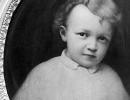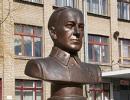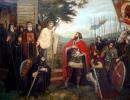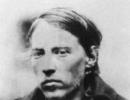Presentation on the topic: "May 9 - Victory Day! The last days of the war! German troops took up defensive positions along the western banks of the Oder and Neisse rivers. On the outskirts of Berlin and in itself.". Download for free and without registration. Presentation for Victory Day presentation for lesson
slide 1
slide 2

Victory Day is a celebration of the victory of the USSR over Nazi Germany in the Great Patriotic War of 1941-1945.
slide 3

Introduced in 1945, but since 1948 it has been a working day. Fireworks on Red Square Nevertheless, the holiday retained its significance, holiday cards were issued and congratulations were addressed to the front-line soldiers. It was first widely celebrated in the USSR only two decades later, already under Brezhnev. In the same anniversary year of 1965, Victory Day again became non-working. During the existence of the USSR, military parades on Red Square on May 9 were in the anniversary years of 1965, 1975, 1985 and 1990; parades were held annually on 7 November.
slide 4

In April 1945, the Red Army came close to Berlin. German troops took up defensive positions along the western banks of the Oder and Neisse rivers. On the approaches to Berlin and in the city itself, a grouping of troops was concentrated, which included 62 divisions (including 48 infantry, 4 tank and 10 motorized), 37 separate infantry regiments and about 100 separate infantry battalions, as well as a significant number of artillery units and divisions. This grouping numbered about a million people, 1,500 tanks, 10,400 guns and mortars, 3,300 combat aircraft.
slide 5

slide 6

On May 1, at 03:50, the Chief of the General Staff of the Wehrmacht Ground Forces, Infantry General Krebs, was delivered to the command post of the 8th Guards Army, declaring that he was authorized to negotiate a truce. However, Stalin ordered no negotiations except for unconditional surrender. An ultimatum was delivered to the German command: if consent to unconditional surrender is not given before 10 o’clock, a crushing blow will be dealt by the Soviet troops.
Slide 7

Slide 8

Slide 9

More than 2 million soldiers and officers, 6,250 tanks and self-propelled guns, 41,600 guns and mortars, and 7,500 aircraft took part in the Berlin operation.
Slide 10

slide 11

For many years, May 9 has been the most sincere and touching holiday. No other holiday can be compared to it. Until now, the symbol of a strong Fatherland is a veteran, whose chest is in orders and walking with his grandson by the hand. There are very few such veterans among us, they could become a real symbol of a strong connection between generations. On Victory Day, each of us feels especially proud of our history. This pride strengthens our belief that we can overcome any adversity.
slide 12

May 9 is a holy holiday for each of us. On this day, we honor the heroes who liberated the world from fascism. All living on earth are obliged to pass on the memory of the victory to their children. Thus, we will be able to transfer the tradition of celebrating Victory Day into the future. The wide development of the Internet and the urgent delivery of flowers allow you to conveniently and quickly place an order and congratulate your grandparents, veterans on this bright event. Victory Day is a new countdown of saved human life. This is a holiday with tears in the eyes and pain in the heart. In the former Soviet Union, grief came to every family during the war. Thousands of husbands and sons went to the front, many of them did not return. On the shoulders of women and children lay back-breaking work in the rear. All the people stood up to defend the Fatherland and were able to defend the right to life under a peaceful sky. Kudos to them for this.
slide 2
Last days of the war
German troops took up defensive positions along the western banks of the Oder and Neisse rivers. On the approaches to Berlin and in the city itself, a grouping of troops was concentrated, which included 62 divisions (including 48 infantry, 4 tank and 10 motorized), 37 separate infantry regiments and about 100 separate infantry battalions, as well as a significant number of artillery units and divisions. This grouping numbered about a million people, 1,500 tanks, 10,400 guns and mortars, 3,300 combat aircraft.
slide 3
By the beginning of the operation, Soviet troops numbered 149 rifle and 12 cavalry divisions, 13 tank and 7 mechanized corps, 15 separate tank and self-propelled brigades with a total strength of more than 1,900,000 people. The 1st and 2nd armies of the Polish Army participating in the operation consisted of 10 infantry and 1 tank
slide 4
On May 1, at 03:50, the Chief of the General Staff of the Wehrmacht Ground Forces, Infantry General Krebs, was delivered to the command post of the 8th Guards Army, declaring that he was authorized to negotiate a truce. However, Stalin ordered no negotiations except for unconditional surrender. An ultimatum was delivered to the German command: if consent to unconditional surrender is not given before 10 o’clock, a crushing blow will be dealt by the Soviet troops.
slide 5
Having received no answer, the Soviet troops at 10:40 opened heavy fire on the remnants of the defense in the center of Berlin. By 18 o'clock it became known that the demands for surrender were rejected. After that, the final assault began on the central part of the city, where the Imperial Chancellery was located. All night, from 1 to 2 May, the fighting for the office continued. By morning, all the premises were occupied by Soviet soldiers.
slide 6
Wilhelm Keitel signing the German Unconditional Surrender Act
Slide 7
More than 2 million soldiers and officers, 6,250 tanks and self-propelled guns, 41,600 guns and mortars, and 7,500 aircraft took part in the Berlin operation.
The losses of the Red Army were enormous: according to official figures, during the Berlin operation, the Soviet troops lost 78,291 people dead and 274,184 people wounded.
Last days of the war! German troops took up defensive positions along the western banks of the Oder and Neisse rivers. On the approaches to Berlin and in the city itself, a grouping of troops was concentrated, which included 62 divisions (including 48 infantry, 4 tank and 10 motorized), 37 separate infantry regiments and about 100 separate infantry battalions, as well as a significant number of artillery units and divisions. This grouping consisted of about a million people, tanks, guns and mortars, combat aircraft. German troops took up defensive positions along the western banks of the Oder and Neisse rivers. On the approaches to Berlin and in the city itself, a grouping of troops was concentrated, which included 62 divisions (including 48 infantry, 4 tank and 10 motorized), 37 separate infantry regiments and about 100 separate infantry battalions, as well as a significant number of artillery units and divisions. This grouping consisted of about a million people, tanks, guns and mortars, combat aircraft.

By the beginning of the operation, the Soviet troops numbered 149 rifle and 12 cavalry divisions, 13 tank and 7 mechanized corps, 15 separate tank and self-propelled brigades with a total strength of more than 1 people. The 1st and 2nd Armies of the Polish Army participating in the operation consisted of 10 infantry and 1 tank Soviet troops by the beginning of the operation consisted of 149 rifle and 12 cavalry divisions, 13 tank and 7 mechanized corps, 15 separate tank and self-propelled brigades with a total strength of more than 15 people. The 1st and 2nd armies of the Polish Army participating in the operation consisted of 10 infantry and 1 tank

On May 1, at 03:50, the Chief of the General Staff of the Wehrmacht Ground Forces, Infantry General Krebs, was delivered to the command post of the 8th Guards Army, declaring that he was authorized to negotiate a truce. However, Stalin ordered no negotiations except for unconditional surrender. An ultimatum was delivered to the German command: if consent to unconditional surrender is not given before 10 o’clock, a crushing blow will be dealt by the Soviet troops. On May 1, at 03:50, the Chief of the General Staff of the Wehrmacht Ground Forces, Infantry General Krebs, was delivered to the command post of the 8th Guards Army, declaring that he was authorized to negotiate a truce. However, Stalin ordered no negotiations except for unconditional surrender. An ultimatum was delivered to the German command: if consent to unconditional surrender is not given before 10 o’clock, a crushing blow will be dealt by the Soviet troops.

Having received no answer, the Soviet troops at 10:40 opened heavy fire on the remnants of the defense in the center of Berlin. By 18 o'clock it became known that the demands for surrender were rejected. After that, the final assault began on the central part of the city, where the Imperial Chancellery was located. All night, from 1 to 2 May, the fighting for the office continued. By morning, all the premises were occupied by Soviet soldiers. Having received no answer, the Soviet troops at 10:40 opened heavy fire on the remnants of the defense in the center of Berlin. By 18 o'clock it became known that the demands for surrender were rejected. After that, the final assault began on the central part of the city, where the Imperial Chancellery was located. All night, from 1 to 2 May, the fighting for the office continued. By morning, all the premises were occupied by Soviet soldiers.


More than 2 million soldiers and officers, tanks and self-propelled guns, guns and mortars, aircraft took part in the Berlin operation. More than 2 million soldiers and officers, tanks and self-propelled guns, guns and mortars, aircraft took part in the Berlin operation. The losses of the Red Army turned out to be huge: according to official data, during the Berlin operation, the Soviet troops lost a man dead and a man wounded. The losses of the Red Army turned out to be huge: according to official data, during the Berlin operation, the Soviet troops lost a man dead and a man wounded.















1 of 14
Presentation on the topic:
slide number 1

Description of the slide:
slide number 2

Description of the slide:
May 9 - by right, can be called the most valuable and touching holiday in the post-Soviet countries. The main thing is that people always think that this is not just a day off and a reason to relax, but this is a day that is recorded in history as a famous date. May 9 - by right, can be called the most valuable and touching holiday in the post-Soviet countries. The main thing is that people always think that this is not just a day off and a reason to relax, but this is a day that is recorded in history as a famous date.
slide number 3

Description of the slide:
This holiday is a little unusual, as it is a holiday with tears in the eyes. Everyone rejoices and celebrates the victory, but at the same time they cry and remember the horrors of those days. This holiday is a little unusual, as it is a holiday with tears in the eyes. Everyone rejoices and celebrates the victory, but at the same time they cry and remember the horrors of those days.
slide number 4

Description of the slide:
In the days of the Great Patriotic War, extraordinary horrors took place, those days are remembered with great difficulty and sadness in front of our eyes. The price for the victory was too high, but people strong in character and will united and wrested victory from the enemy with their teeth. In the days of the Great Patriotic War, extraordinary horrors took place, those days are remembered with great difficulty and sadness in front of our eyes. The price for the victory was too high, but people strong in character and will united and wrested victory from the enemy with their teeth.
slide number 5

Description of the slide:
Every year, thanks to such a great holiday, people celebrate, dance, sing and, of course, set off beautiful fireworks on the streets of many cities. Every year, thanks to such a great holiday, people celebrate, dance, sing and, of course, set off beautiful fireworks on the streets of many cities.
slide number 6

Description of the slide:
This day is very important in the history of many countries, so everyone immediately remembers the military, and understand how brave and strong people they are. Military parades are held, in some places, you can taste delicious food from a real field kitchen. It is important to know that not all my life, parades were held on this day. This day is very important in the history of many countries, so everyone immediately remembers the military, and understand how brave and strong people they are. Military parades are held, in some places, you can taste delicious food from a real field kitchen. It is important to know that not all my life, parades were held on this day.
slide number 7

Description of the slide:
May 9 - is considered a public holiday, it received such a name back in 1945, on this day the Wehrmacht surrendered. May 9 - is considered a public holiday, it received such a name back in 1945, on this day the Wehrmacht surrendered.
slide number 8

Description of the slide:
As they say, the most difficult is always at the end, so the last days of the war were very difficult. The German fascists were strong in spirit, even after the suicide of their Fuhrer Hitler, they did not break and continued to fight. But the strength of spirit and will of the united peoples won in this difficult war. As they say, the most difficult is always at the end, so the last days of the war were very difficult. The German fascists were strong in spirit, even after the suicide of their Fuhrer Hitler, they did not break and continued to fight. But the strength of spirit and will of the united peoples won in this difficult war.
slide number 9

Description of the slide:
An interesting fact is that during the war, salutes were banned. But, after the capture of Berlin, cannon volleys were launched in all cities, and in the hero city of Moscow, people watched the largest fireworks of all time. More than 1000 guns took part in that salute, and about 30 volleys of them sounded. An interesting fact is that during the war, salutes were banned. But, after the capture of Berlin, cannon volleys were launched in all cities, and in the hero city of Moscow, people watched the largest fireworks of all time. More than 1000 guns took part in that salute, and about 30 volleys of them sounded.
slide number 10

Description of the slide:
Also, in history there is a famous day in June 1945. In June, a parade was held, which was attended by people to whom everyone is indebted for the victory. This is the great and unique Soviet military leader - Georgy Konstantinovich Zhukov (he hosted the parade), and the great commander of the Soviet Union - Konstantin Konstantinovich Rokossovsky (he commanded the parade). Also, in history there is a famous day in June 1945. In June, a parade was held, which was attended by people to whom everyone is indebted for the victory. This is the great and unique Soviet military leader - Georgy Konstantinovich Zhukov (he hosted the parade), and the great commander of the Soviet Union - Konstantin Konstantinovich Rokossovsky (he commanded the parade).
Description of the slide:
When L.I. Brezhnev, then "Victory Day" resumed its existence, and everyone honored and remembered this day. In addition, military parades began every 10 years in Moscow. But, after the collapse of the USSR, this holiday went into the shadows. When L.I. Brezhnev, then "Victory Day" resumed its existence, and everyone honored and remembered this day. In addition, military parades began every 10 years in Moscow. But, after the collapse of the USSR, this holiday went into the shadows.
slide number 13

Description of the slide:
Since 1995, 2 military parades have taken place in the capital of Russia, after which May 9 again became a great date. But, the parades were held without equipment. Only in 2008, equipment appeared at the parades, that is, the tradition was restored. Since 1995, 2 military parades have taken place in the capital of Russia, after which May 9 again became a great date. But, the parades were held without equipment. Only in 2008, equipment appeared at the parades, that is, the tradition was restored.
slide number 14

Description of the slide:
To use the preview of presentations, create a Google account (account) and sign in: https://accounts.google.com
Slides captions:
MBDOU "Romodanovsky kindergarten of a combined type" Prepared by the educator: Zhbanova L.A. 2015 "Let's bow to those great years!"
The happiness of the Motherland is peace and freedom, They are indestructible like granite. May day of the forty-fifth year Our memory keeps safe!
The life of people before the war. Nothing foreshadowed trouble.
But suddenly peaceful life was destroyed by explosions
Grief and fear fell on people: children, women, old people.
Millions of men went to defend their homeland!
They fought valiantly and gave their lives for us to live in peace
Monument to a soldier who saved a German girl It was in May at dawn, The battle grew near the walls of the Reichstag. The German girl was noticed by Our soldier on the dusty pavement. She stood at the pillar, trembling, Fear froze in her blue eyes, And pieces of whistling metal Sowed death and torment around ... Then he remembered how, saying goodbye in the summer, He kissed his daughter, Maybe the girl's father of this daughter shot her own ... But Now, in Berlin, under shelling, A fighter crawled and, shielding his body, Carefully carried a girl in a short white dress out of the fire.
It was difficult, but the Soviet troops defeated the enemy forces of Germany, setting the banner of victory over the Reichstag!
War is over!!! Joy, laughter and tears...
They won at a very EXPENSIVE price! A huge THANK YOU and low bow to you, dear veterans!
For heroism and exploits in the war, soldiers were awarded orders and medals. Combat Merit Medal
Order of the Red Star Order of Victory
St. George's ribbon - a symbol of Victory Day St. George's ribbon - bicolor (two-color) Orange and black colors. Black means smoke, Orange means flame.
We remember the exploits of our soldiers Mamaev Kurgan in Volgograd Monument - "Motherland Calls" Monument to the soldiers of the Soviet Army who fell in battles against fascism.
Monument - "Defenders of Moscow" Poklonnaya Hill in Moscow
Eternal Flame at the Tomb of the Unknown Soldier On May 8, 1967, an eternal flame broke out at the Tomb of the Unknown Soldier.
Fireworks in May 1945
Festive fireworks of our days.






